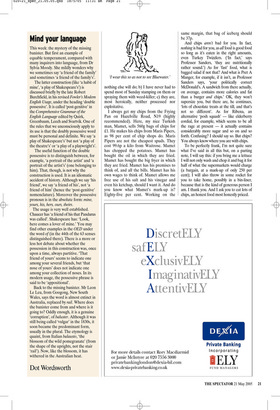Mind your language
This week: the mystery of the missing banister. But first an example of equable temperament, compared with many inquirers into language, from Dr Sylvia Moody. She mildly wonders why we sometimes say ‘a friend of the family’ and sometimes ‘a friend of the family’s’.
The latter construction (like ‘a habit of mine’, ‘a play of Shakespeare’s’) is discussed briefly by the late Robert Burchfield, in his revised Fowler’s Modern English Usage, under the heading ‘double possessive’. It is called ‘post-genitive’ in the Comprehensive Grammar of the English Language edited by Quirk, Greenbaum, Leech and Svartvik. One of the rules that we unconsciously apply to its use is that the doubly possessive word must be personal and definite. We say ‘a play of Shakespeare’s’ but not ‘a play of the theatre’s’ or ‘a play of a playwright’s’.
The useful function of the double possessive is to distinguish between, for example, ‘a portrait of the artist’ and ‘a portrait of the artist’s’ (one belonging to him). That, though, is not why the construction is used. It is an idiomatic accident of history. Although we say ‘his friend’, we say ‘a friend of his’, not ‘a friend of him’ (hence the ‘post-genitive’ nomenclature). Moreover the possessive pronoun is in the absolute form: mine, yours, his, hers, ours, theirs.
The usage is very well established. Chaucer has ‘a friend of his that Pandarus was called’. Shakespeare has: ‘Look, here comes a lover of mine.’ You may find other examples in the OED under the word of (in the 44th of the 63 senses distinguished there). There is a more or less hot debate about whether the possession in this construction was, once upon a time, always partitive. ‘That friend of yours’ seems to indicate one among your several friends, but ‘that nose of yours’ does not indicate one among your collection of noses. In its modern usage, the possessive phrase is said to be ‘appositional’.
Back to the missing banister. Mr Leon Le Leu, from Googong, New South Wales, says the word is almost extinct in Australia, replaced by rail. Where does the banister come from and where is it going to? Oddly enough, it is a genuine ‘corruption’, of baluster. Although it was still being called ‘vulgar’ in the 1830s, it soon became the predominant form, usually in the plural. The etymology is quaint, from Italian balausto, ‘the blossom of the wild pomegranate’ (from the shape of the uprights, not the stair ‘rail’). Now, like the blossom, it has withered in the Australian heat.
Dot Wordsworth

























































 Previous page
Previous page